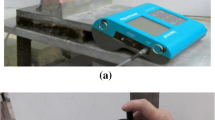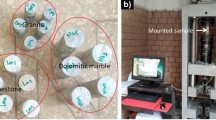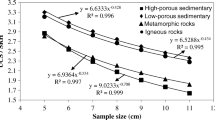Abstract
In order to utilize the Equotip hardness tester, originally developed in the field of metallic engineering, as an indirect method to predict the unconfined compressive strength (UCS) of rock, laboratory tests were undertaken to establish the UCS, Equotip hardness (L-value) and porosity of nine rock types. Using existing data from Verwaal and Mulder (Int J Rock Mech Min Sci Geomech Abstr 30:659–662, 1993) and the results of laboratory tests, an equation relating UCS (MPa) and L-value obtained from single impacts (L s) and porosity (n %) was derived, which provides a close approximation of the UCS value. An equation to relate UCS and Equotip hardness is also presented, although this is less accurate. It is considered Equotip testing has advantages over the commonly used Schmidt hammer test.
Résumé
Afin d’utiliser la mesure de dureté Equotip, originellement développée dans le domaine des métaux, comme méthode indirecte de caractérisation de la résistance à la compression simple des roches, des essais de laboratoire ont été réalisés sur neuf types de roches afin de déduire la résistance à la compression simple (UCS), de la dureté Equotip (indice L) et de la porosité. Utilisant les données publiées par Verwaal et Mulder (Int J Rock Mech Min Sci Geomech Abstr 30:659–662, 1993) et les résultats des essais de laboratoire, une équation reliant les valeurs UCS (en MPa), les indices L obtenus pour des impacts isolés (Ls) et la porosité n (en %) a été établie et permet d’obtenir une valeur approchée, assez précise, de la valeur UCS. Une équation reliant la valeur UCS et la dureté Equotip est également présentée, bien que moins précise. On peut considérer que la dureté Equotip présente un intérêt certain par rapport à la dureté mesurée au marteau de Schmidt.






Similar content being viewed by others
References
Anan S (1997) Application of rebound hardness tester to rock material: an attempt to material classification by Equotip hardness testing. In: Proceedings of the Conference on Japan Society of Engineering Geology, Chugoku-Shikoku District. pp 15–18 (in Japanese)
Hack HRGK, Hingira J, Verwaal W (1993) Determination of discontinuity wall strength by Equotip and ball rebound tests. Int J Rock Mech Min Sci Geomech Abstr 30:151–155
Kahraman S, Fener M, Gunaydin O (2004) Predicting the sawability of carbonate rocks using multiple curvilinear regression analysis. Int J Rock Mech Min Sci 41:1123–1131
Kawasaki S, Yoshida M, Tanimoto C, Masuya T (2000) The development of property evaluation method for rock materials based on the simple rebound hardness test: investigations on the effects of test conditions and fundamental properties. J Jpn Soc Eng Geol 41:230–241 (in Japanese with English abstract)
Kawasaki S, Tanimoto C, Koizumi K, Ishikawa M (2002) An attempt to estimate mechanical properties of rocks using the Equotip hardness tester. J Jpn Soc Eng Geol 43:244–248 (in Japanese with English abstract)
Meulenkamp F, Grima MA (1999) Application of neural networks for the prediction of the unconfined compressive strength (UCS) from Equotip hardness. Int J Rock Mech Min Sci 36:29–39
Okawa S, Ohoka M and Funato A (1999) Application of hardness tester to rock specimens. In: Proceedings of the 29th symposium of rock mechanics. pp 256–260 (in Japanese with English abstract)
Proceq SA (1977a) Operating instructions concrete test hammer types N and NR. Zurich, Switzerland
Proceq SA (1977b) Equotip operations instructions, 5th edn. PROCEQ SA Zurich, Switzerland
Schmidt E (1951) A non-destructive concrete tester. Concrete 59:34–35
Verwaal W, Mulder A (1993) Estimating rock strength with the Equotip hardness tester. Int J Rock Mech Min Sci Geomech Abstr 30:659–662
Acknowledgments
The authors wish to express their deep gratitude to Professor Emeritus Tsuguo Sunamura, Osaka University, for fruitful discussions and for reading the early version of the draft. This research has been financially supported by the Sasagawa Scientific Research Grant from The Japan Science Society in 2004, held by Aoki, and by the Science Research Fund of the Japan Society for the Promotion of Science (16300292) through Matsukura.
Author information
Authors and Affiliations
Rights and permissions
About this article
Cite this article
Aoki, H., Matsukura, Y. Estimating the unconfined compressive strength of intact rocks from Equotip hardness. Bull Eng Geol Environ 67, 23–29 (2008). https://doi.org/10.1007/s10064-007-0116-z
Received:
Accepted:
Published:
Issue Date:
DOI: https://doi.org/10.1007/s10064-007-0116-z




